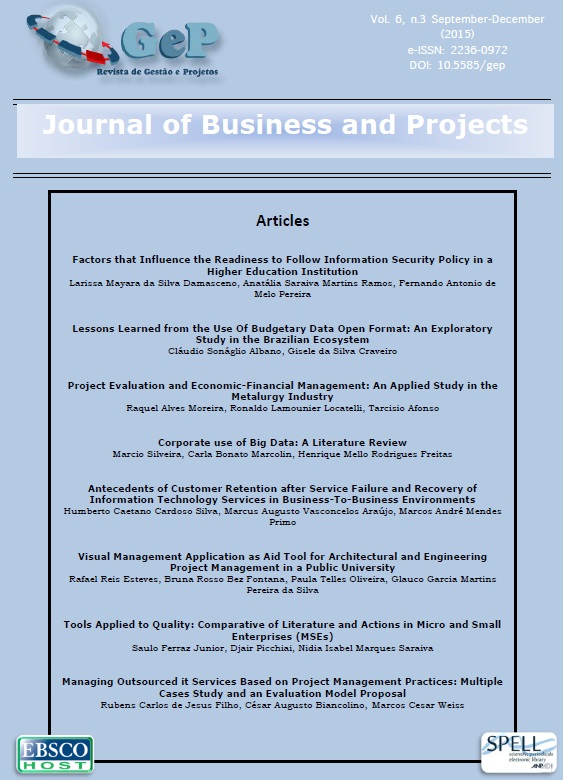Factors that Influence the Readiness to Follow Information Security Policy in a Higher Education Institution
DOI:
https://doi.org/10.5585/gep.v6i3.381Keywords:
Information Security Policy, Security User Behavior, Deterrence Theory.Abstract
Information is a strategic resource for organizations. Academic studies and market researches showed that the information has protective tools violated in higher degree by employees than by external threats, which demand implementation of Information Security Policy to ensure confidentiality, integrity and availability. This study aims to investigate extrinsic and intrinsic motivators that affect student readiness to comply with security policy which will proposed by university. In the literature review were discussed the issues of information security and deterrence theory together with behavioral factors that influence individual readiness. Therefore, was applied a survey with 18 items in Likert scale concordance, with five points, that focused in readiness factors. The research method is composed of quantitative techniques, being: factorial analysis, cluster and logistic regression. The results showed that sample was fragmented in two groups: higher readiness and smaller readiness to follow security policy. In conclusion, it evidenced that severity of punishment has the most influence on user’s readiness.
References
Albreschstsen, E. Hovden, J (2009). The information security digital divide between managers and users. Computers & Security. 28(6), 476-490. Retrieved in October 2, 2014, from http://www.sciencedirect.com/science/article/pii/S0167404809000029.
Albuquerque Junior, A. E.; Santos, E. M. (2014a, setembro). Análise das publicações brasileiras sobre segurança da informação sob a ótica social em periódicos científicos entre 2004 e 2013. Encontro Anual da Associação Nacional de Pós-Graduação em Administração, Rio de Janeiro, RJ, Brasil, 38.
Albuquerque Junior, A. E.; Santos, E. M. (2014b, maio) Produção científica sobre segurança da informação em eventos científicos brasileiros. International Conference on Information Systems and Technology Management, São Paulo, SP, Brasil, 11.
Albuquerque Junior, A. E.; Santos, E. M. (2013, setembro). Produção científica sobre segurança da informação em anais de eventos da ANPAD. Encontro de Administração da Informação, Bento Gonçalves, RS, 4.
Appel-silva, M.; Welter, G.; Argimon, I. L. (2010). A teoria da autodeterminação e as influências socioculturais sobre a identidade. Psicol. rev. (Belo Horizonte). 16(2),351-369. Recuperado em 04 novembro, 2013, de http://pepsic.bvsalud.org/scielo.php?script=sci_arttext&pid=S1677-11682010000200008&lng=pt&nrm=iso
Aronson, E.; Wilson, T. D.; Arket, R. M. (2002). Psicologia Social (3ª ed.). Rio de Janeiro: LTC.
Baltzan, P.; Phillips, A. (2012). Sistemas de Informação. McGraw Hill: Porto Alegre, 2012.
D’Andrea, E. R. P. (2004) Segurança da Informação: uma visão estratégica para as organizações. (Albertin, A. L.; Moura, R. M.,org.). (Tecnologia de Informação). São Paulo, Atlas,
Datt, F. Empresas se armam para combater fraudes.(2012) Assurance Journal. (Publicação do Departamento Marketing da Ernst & Young Terco). 17, 14-25.Recuperado em 14 novembro, 2013 de http://www.ey.com.br/Publication/vwLUAssets/Assurance_17_PDF/$FILE/Assurance.journal_n.17_Julho_Agosto.pdf
D’arcy, J.; Hovav, A.; Galletta, D (2009). User Awareness of Security Countermeasures and Its Impact on Information Systems Misuse: A Deterrence Approach. Information Systems Research. 20 (19), 79-88. Mar. Retrivied in November 8, 2013, from http://pubsonline.informs.org/doi/abs/10.1287/isre.1070.0160.
Doherty, N. F.; Fulford, H. Aligning the information security policy with the strategic information systems plan. Computers & Security,(25),55-63, 2005. Retrieved in November 2, 2013, fromhttp://ac.els-cdn.com/S0167404805001720/1-s2.0-S0167404805001720-main.pdf?_tid=4e1be27a-4442-11e3-b442-00000aacb35d&acdnat=1383453914
Furnell, S; Thomson; K. L. (2009). From culture to disobedience: recognizing the varying user acceptance of IT security. Computer Fraud & Security. (2), 5-10. Retrieved in April 9, 2013, from http://www.sciencedirect.com/science/article/pii/S1361372309700193
Gaunt, N. (1998) Installing an appropriate information security police. International Journal of Medical Informatics. 49(1),131-134. Retrieved in June 15, 2014, from http://www.ijmijournal.com/article/S1386-5056(98)00022-7/abstract
Hair Jr, J. F.; Black, W. C.; Babin, B. J., Anderson; R. E.; Tatham, R. L. (2009) Análise multivariada de dados. (6.ed). Porto Alegre: Artmed.
Herath, T.; Rao, H. R. (2009). Encouraging information security behaviors in organizations: Role of penalties, pressures and perceived effectiveness. Decision Support Systems.47, 154-165, ed in April 09, 2013 from http://www.sciencedirect.com/science/article/pii/S0167923609000530
Höne, K.; Eloff, J.H.P. Information security policy (2002) – what do international information security standards say? Computers & Security, 21 (5), 402-409. Retrieved in November 03, 2013, from http://www.sciencedirect.com/science/article/pii/S0167404802005047
IBGE (2013, dezembro). Sala de imprensa: Acesso à internet e posse de telefone móvel celular para uso pessoal em 2011. Recuperado em 14 fevereiro, 2014 de http://ftp.ibge.gov.br/Acesso_a_internet_e_posse_celular/2011/PNAD_Inter_2011.pdf
Loiola, R. (2009, outubro). Geração Y. Revista Galileu, 219/comportamento. p. out 2009. Recuperado em 30 novembro, 2014, de http://revistagalileu.globo.com/Revista/Galileu/0,,EDG87165-7943-219,00-GERACAO+Y.html
Maciel, C. O.; Camargo, C. (2011). Comprometimento, satisfação e cooperação no trabalho: evidências da primazia dos aspectos morais e das normas de reciprocidade sobre o comportamento. Revista de Administração Contemporânea. 15(3), 433-453. Recuperado em 04 novembro, de Disponível em: http://www.anpad.org.br/periodicos/arq_pdf/a_1188.pdf
Mattord, H. J; Whitman, M. E (2004). Improving Information Security Through Policy Implementation" SAIS 2004 Proceedings. Paper 41. Retrieved in August 20, 2013 in: http://aisel.aisnet.org/sais2004/41
Marôco, J. (2007) Análise estatística com utilização do SPSS. (3ª ed.). Lisboa: Sílabo.
Meyer, J.P.; Allen, N. J. (1991) A three-component conceptualization of organizational commitment. Human Resource Management Review. 1(1),61-89. Retrivied in October 30, 2014 in http://cyb.ox.or.kr/lms_board/bbs_upload/%C1%B6%C1%F7%B8%F4%C0%D4-%B1%B9%BF%DC%B3%ED%B9%AE.pdf
Mendonça, H. (2015, fevereiro 23). Conheça a geração z: nativos digitais que impõem desafios às empresas. El País Brasil, carreira. Recuperado em 10 março, 2016, de http://brasil.elpais.com/brasil/2015/02/20/politica/1424439314_489517.html
Pahnila, S.; Siponen, M.; Mahmood, A. (2007, January). Employees’ Behavior towards IS Security Policy Compliance. Proceedings of the 40th Hawaii International Conference on System Sciences, Waikoloa, Big Island, HI,3-6. Retrieved in November 4, 2013 in http://citeseerx.ist.psu.edu/viewdoc/download?doi=10.1.1.106.7038&rep=rep1&type=pdf"type=pdf
Parasuraman, A.(2000) Technology Readiness Index (Tri): a multiple item scale to measure readiness to embrace new Technologies. Journal of Service Research. 2(4), 307-320. Retrieved in July 16, 2015, from http://jsr.sagepub.com/content/2/4/307.abstract
Pereira, F. A. M. (2013). A satisfação e a intenção de continuidade de uso em serviços de e-learning: validação empírica de um modelo aplicado no serviço público. Dissertação de mestrado, Universidade Federal do Rio Grande do Norte, Natal, RN, Brasil.
PWC. (2013). Principais resultados da Pesquisa Global de Segurança da Informação 2013 – The Global State of Information Security Survey 2013. Brasil. Recuperado em 5 novembro, 2014, em http://www.pwc.com.br/pt_BR/br/estudos-pesquisas/assets/pesquisa-seguranca-inforrmacao-13.pdf
PWC. (2014). Principais resultados da Pesquisa Global de Segurança da Informação 2014 - The Global State of Information Security Survey 2014. Brasil: 2014. Recuperado em 14 junho, 2015, em http://www.pwc.com.br/pt_BR/br/estudos-pesquisas/assets/pesquisa-seguranca-inforrmacao-14.pdf
Rodrigues, A.; Assmar, E. M. L.; Jablonski, B. (2012) Psicologia social. (29ª ed). Petrópolis: Vozes.
Silva Netto, A.; Silveira, M. A. P. (2007). Gestão da segurança da informação: fatores que influenciam sua adoção em pequenas e médias empresas. Journal of Information Systems and Technology Management (Online).4 (3), 375-397. Retrieved in November 28, 2013, from http://www.scielo.br/scielo.php?script=sci_arttext&pid=S1807-17752007000300007&lng=en&nrm=iso.
Thomsom, K.; Nierkek, J. V. (2012) Combating information security apathy by encouraging prosocial organisational behaviour. Information Management & Computer Security. 20 (1), 39-46. Retrieved in May 8, 2012, from www.emeraldinsight.com/0968-5227.htm.
Viapiana, L.T. (2006) Economia do crime: uma explicação para a formação do criminoso. Porto Alegre: AGE,
Von Solms, B. (2001) Corporate governance and information security. Computers & Security. 20(3), 215-218. Retrieved in May 15, 2013, from http://citeseerx.ist.psu.edu/viewdoc/download?doi=10.1.1.103.1168&rep=rep1&type=pdf.
Downloads
Published
How to Cite
Issue
Section
License
Copyright (c) 2016 Larissa Mayara da Silva Damasceno, Anatália Saraiva Martins Ramos, Fernando Antonio de Melo Pereira

This work is licensed under a Creative Commons Attribution-NonCommercial-NoDerivatives 4.0 International License.







